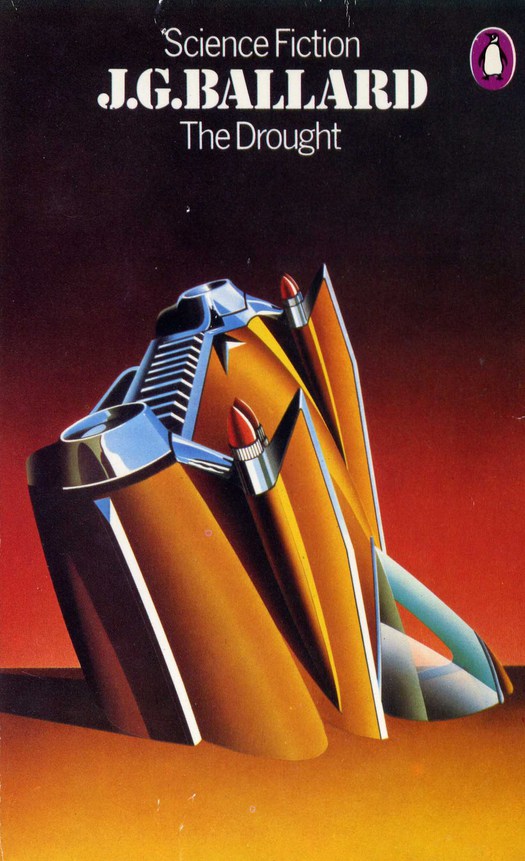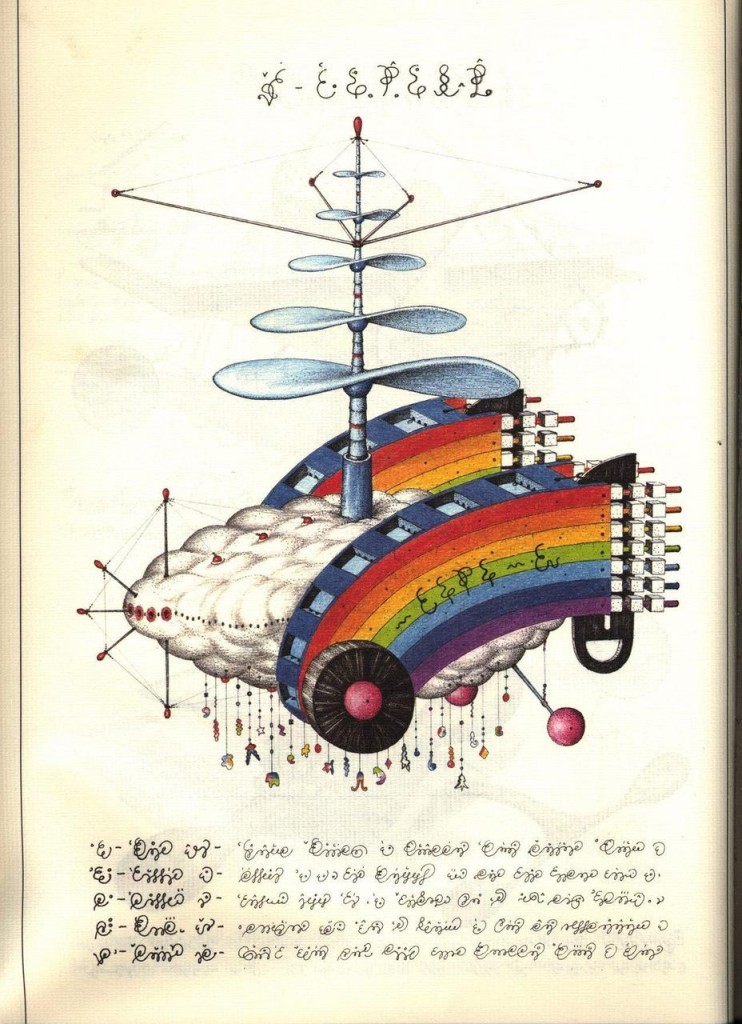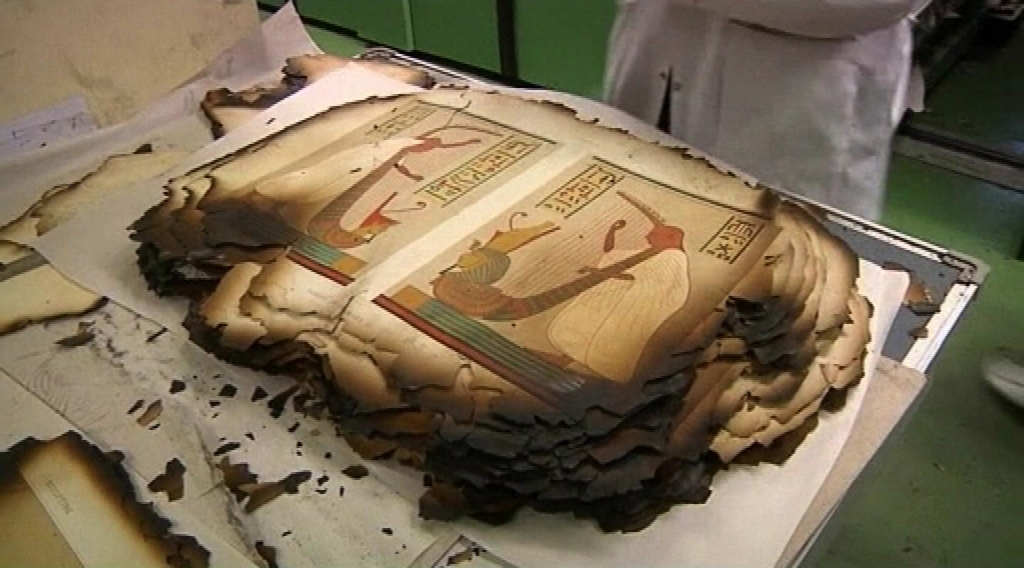
des livres rares en cours de restauration (29 février 2012)
In a concave mirror I saw a star
in the form of a snail…
between the navel of Pegasus,
the girdle of Andromeda,
and the head of Cassiopea1
On saturday 17 december 20112 a fire burned the XXth century cairote building of the Institut d’Égypte, near Tahrir Square. Established by Bonaparte in 1798, the Institut remained a research centre hosting an important and priceless collection of rare books and manuscripts. Amongst those the Description de l’Égypte, a suite of publications mostly in a Mammutfolio format and describing the ancient, modern and natural history of Egypt.
Volume one of the Description of Egypt’s Natural history presents a series of engraved drawings by Jules-César Savigny and aims at compiling images of all living birds. Interestingly enough, one is of the ibis, famous for symbolizing Thoth.
In the Egyptian Pantheon, Thot is regarded as one of its most important deities. God of the Moon, he is described as being the scribe of the sun god Re and thus «is credited for the invention of writing and alphabets»3.
When Egypt is hellenized under Pharaoh Amasis, the Greeks associate Thoth with Hermes. And it is during the Ptolemaic period that the association of the two names becomes official as stated on the Rosetta Stone4. It is also on the same Stone that the adjective Trismegistus (thrice great) is sutured to this new version of Hermes.
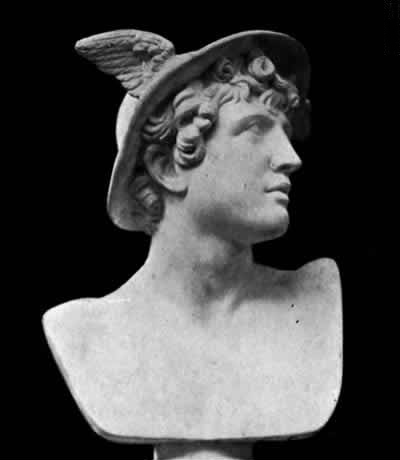
Hermes bust (n.d.)
A number of books were attributed to this newly founded character of Hermes Trismegistus, one of which, The Hermetic Corpus, sets the term hermetic as a derivative of the name Hermes. In late antiquity Hermetism is considered as important as Neoplatonism and Gnosticism: it is a mélange of Platonism, Stoicism and bares few traces of persian and judaic influences5. A typical model of syncretism, The Hermetic Corpus with its seventeen books written in Greek, defends a certain philosophy leaning towards pagan religious practices, the veneration of images and the quest for the purification of one’s soul.
The Renaissance rediscovers Hermetism with a new favored taste for old writings and alchemy. As Dominique Bertrand mentions:
Alchemy is mainly influenced by Hermes Trismegistus. The ambiguity that characterizes him presages the nature of the alchemical connaissance, sealed in the guise of an enigma in a game of signs and intersigns, symbols and cryptic legends [our translation]6.
As centuries passed, Hermetism expanded to become Hermeticism and included, beyond alchemy, all sort of esoterical practices. Yet for Bernard Joly, «alchemical theories in the XVIIth century were frequently called hermetic because of their attachment to an independent tradition started by Hermes Trismegistus and not by Aristotle or Galen. Despite its references to a mythical tradition, alchemy is not an occult science. Classical alchemy was the chemistry of its time and has to be distinguish from irrational tenets, which expanded during the XIXth century as esoterism»7.
Hermetism, whether a science, a philosophy or a gnosis, largely influenced the early and late Renaissance period with intellectual and religious figures, mentions Frances Yates, as Pic de la Mirandole, Marsile Ficin, Giordano Bruno, etc.8. The XVIIth century could in return be seen, according to Joly, as a time for scientific and rational hermetism.
In the following centuries, the influence went on with an obsession for secretive and cryptical methods, and for Bertrand:
One can consider Lacan as an hermesian, his love of the jeu de mots an echo of the phonetic cabala or language of the birds with which the alchemists embedded their secrets [our translation]9
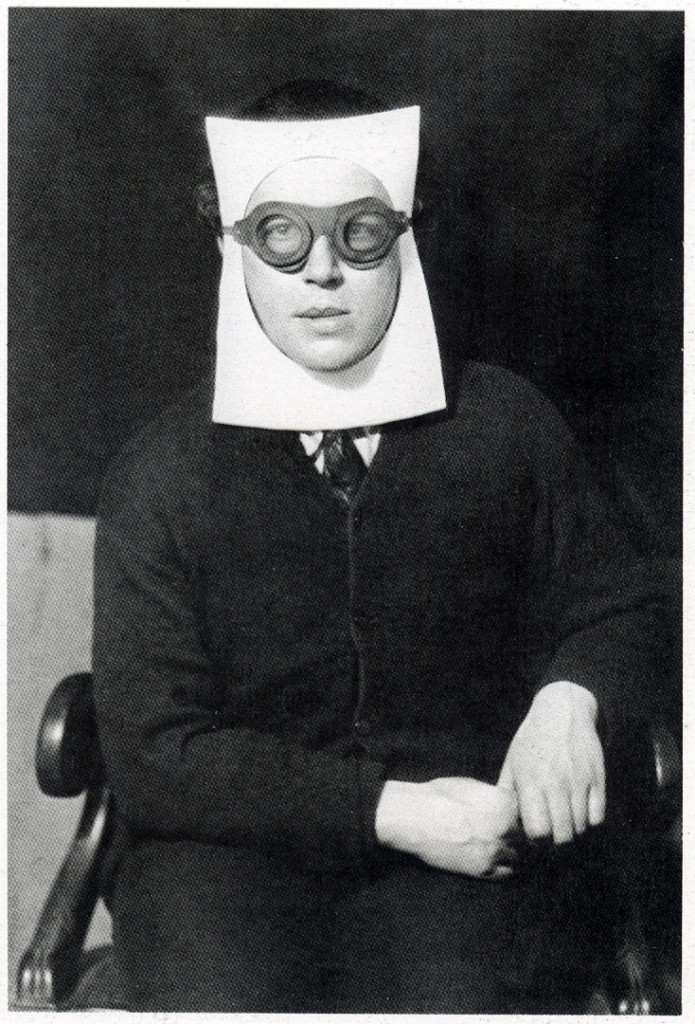
Man Ray, Portrait of André Breton, c.1930
Another adept of hermetic combinations is André Breton, ironically called the Pope of Surrealism. If  anything, surrealism was certainly not a religion, rather a constant sometimes excessive revolution praising the esoterical and the irrational. Transgressing the border of logic, the surrealists explored the limits of reality building the storied technic of pure psychic automatism.
An anticipation of this new model of writing is audibly visible in a play on words that Breton invents with Aragon in 1925: instead of properly spelling littérature, they break the word in three and reassemble this triumvirat of ruins in a sentence: lis tes ratures,10 which could be translated as ‘read your strikethroughs’. Playing with the sound of the word, Breton operates a form of «dépaysement» from its original meaning11; a word can thus be heard and understood in a entirely different way: its essence is transformed, a different and perhaps de-familiarized meaning raising from this operation.
Therefore, hermetism may be seen as a form of dépaysement: it can be understood as the construction of an act of de-familiarization: common words and figures are extracted of their milieu to be modified in a gesture quasi similar to the one of the Grand Œuvre or Magnum Opus: an alchemical metamorphosis, a transmutation to gold12. The use of crypted symbols, only accessible to a few, preserves a veil of secret and in turn allows for all kinds of new interpretations.
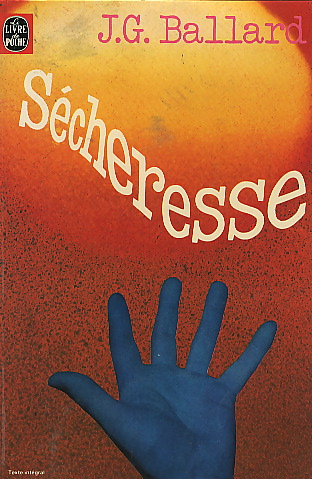
Cover by Pierre Faucheux for the Livre de Poche, c.1980s
In his novel The Drought (1965), a surreal tale of a world without rain, J.G. Ballard describes dried landscapes that parallel the stones Antonin Artaud tries to visually decypher in La Montagne des Signes (1937)13. Quoting Ballard, biograph Andrzej Gasiorek writes:
She was looking out over the bleached bed of the river, and at the brittle trees along the banks, ciphers suspended in the warm air. Ransom began to speak, but this cryptic alphabet seemed to overrule anything he might say14.
This «ruined topography» with its deformed natural elements15 draws a seemingly incoherent message as hard to decode as it may offer an intriguing case of pareidolia.
There is certainly a fine line between the hermetic and the concealed. One can walk that string arguably elitist at times, yet this idea of a hidden meaning prevails in two examples of fictional alphabets, which have, in their respective context of creation, moved away from a pejorative interpretation of the adjective hermetic.
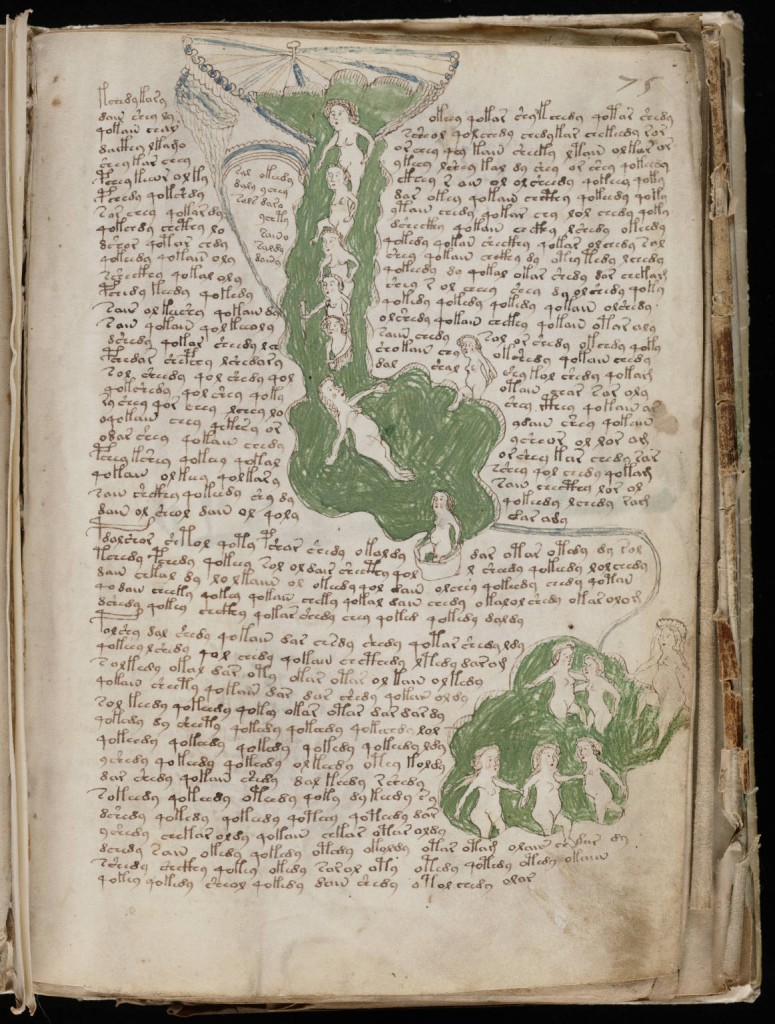
The Voynich Manuscript, c.1408-1436 (Beinecke Rare Book & Manuscript Library, Yale University)
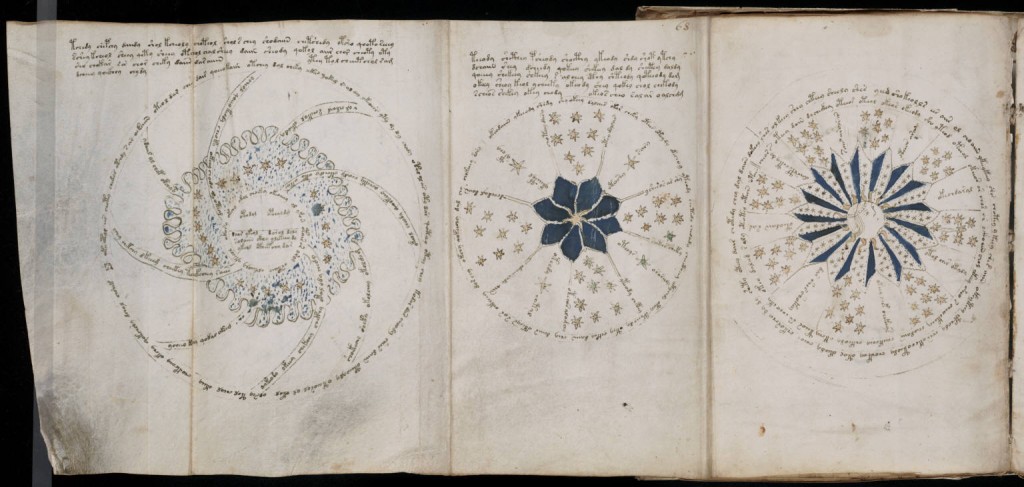
The Voynich Manuscript, c.1408-1436 (Beinecke Rare Book & Manuscript Library, Yale University)
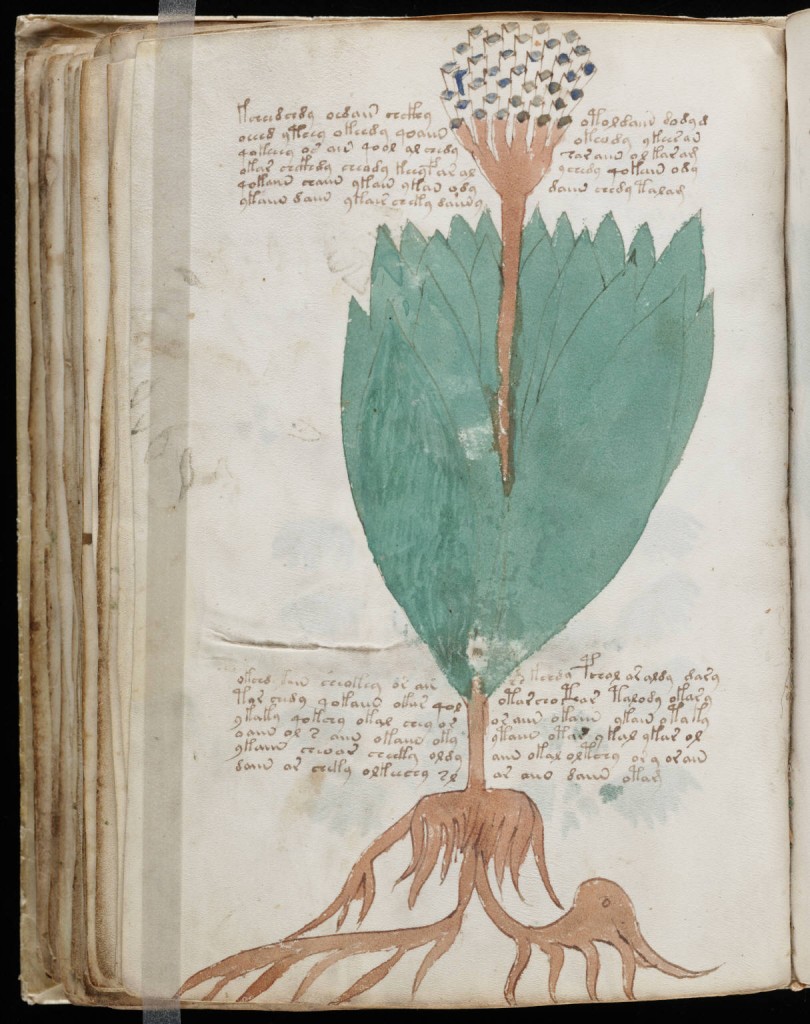
The Voynich Manuscript, c.1408-1436 (Beinecke Rare Book & Manuscript Library, Yale University)
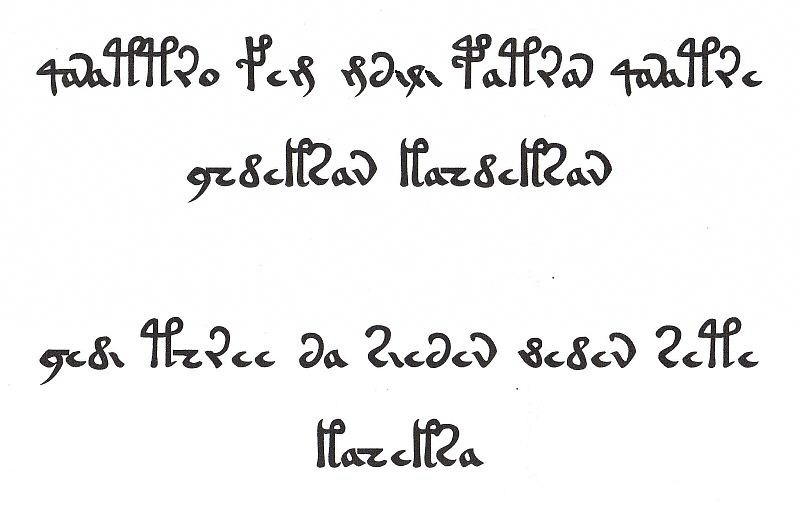
a digitalized version of the curious alphabet of the Voynich Manuscript
The Voynich manuscript (VM) is called by cryptographer D’Imperio «an elegant enigma»16. The book was donated in 1969 to the Yale University by antiquarian H.P. Kraus who had bought it in 1961. However it is antiquarian bookseller and bibliophile Wilfrid Voynich who first owned it. The curious codex written, probably, in Central Europe around the end of the XVth century, was bought by Voynich to a Jesuit College in Frascati in 1912.
The VM seems to be written in an unknown language, «it is an alphabetic script, but of an alphabet variously reckoned to have from nineteen to twenty-eight letters, none of which bear any relationship to any English or European letter system»17. The mystery surrounding this lost or intentionally obscured language has become a challenge for all crytographers since Voynich’s attempts at decyphering the content of the book in the late 1910s.
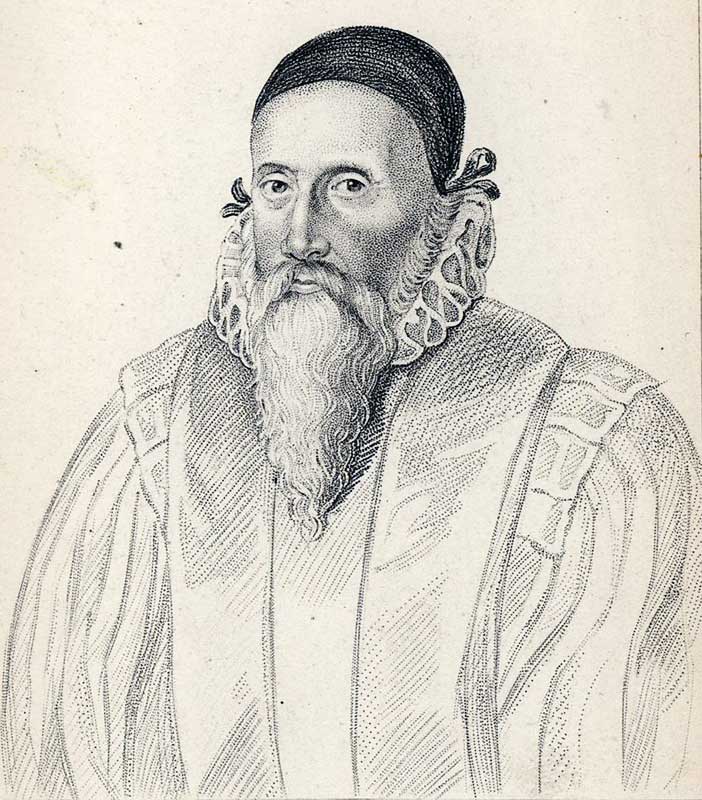
Portrait of John Dee (n.d.)
In 1919 William Romaine Newbold, a specialist of medieval philosophy from the University of Pennsylvania and a amateur cryptographer, tried to crack the secret behind the VM’ fictional alphabet. Basing his research on the fact that Voynich had discovered that the codex had belonged to John Dee, Queen Elizabeth I’s personal astrologer and admirer of Roger Bacon, Newbold arbitrarly decided that the VM was one of those hermetic codex concealing its secrets using an anagramming process18.
Slowly the signs started to speak. A sentence, possibly a caption, was translated by Newbold. Sitting next to an image ressembling a nebula it eventually ment: «In a concave mirror I saw a star in the form of a snail… between the navel of Pegasus, the girdle of Andromeda, and the head of Cassiopea».
The expression concave mirror is important here. To Newbold it was even a key allowing to read the many illustrations and the text alike:
His singular hypothesis held that the visible text is meaningless itself, but that each apparent ‘letter’ is in fact constructed of a series of tiny markings only discernible under magnification. These markings were supposed to be based on ancient Greek shorthand, forming a second level of script that held the real content of the writing19.
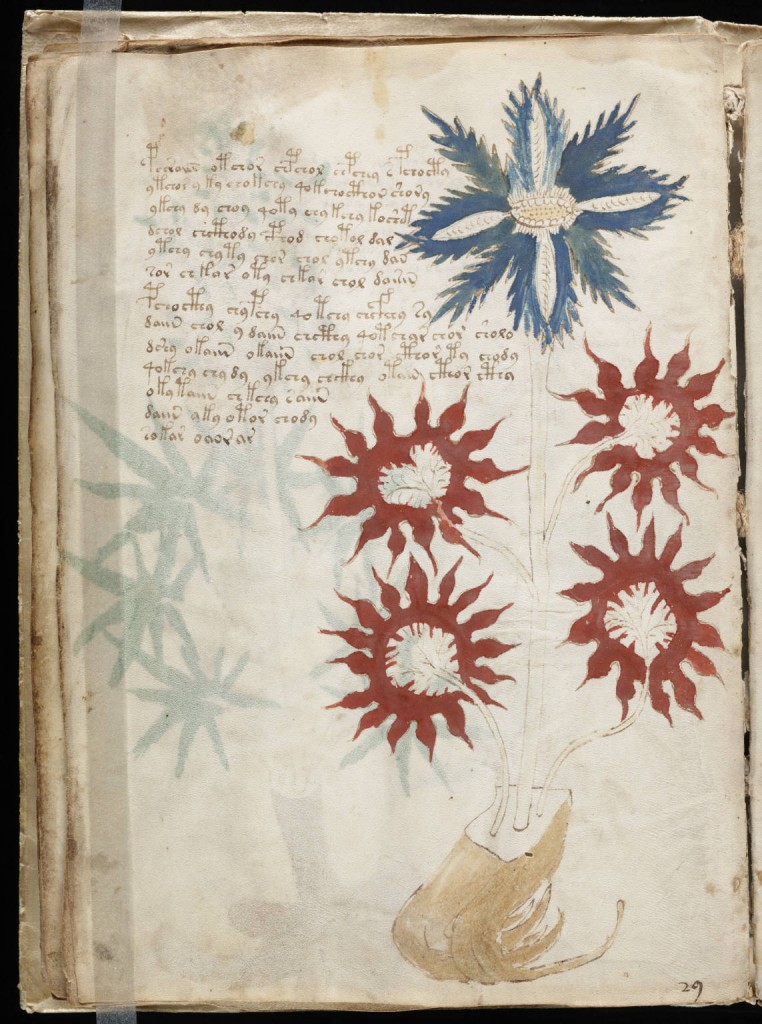
The Voynich Manuscript (Beinecke Rare Book & Manuscript Library, Yale)
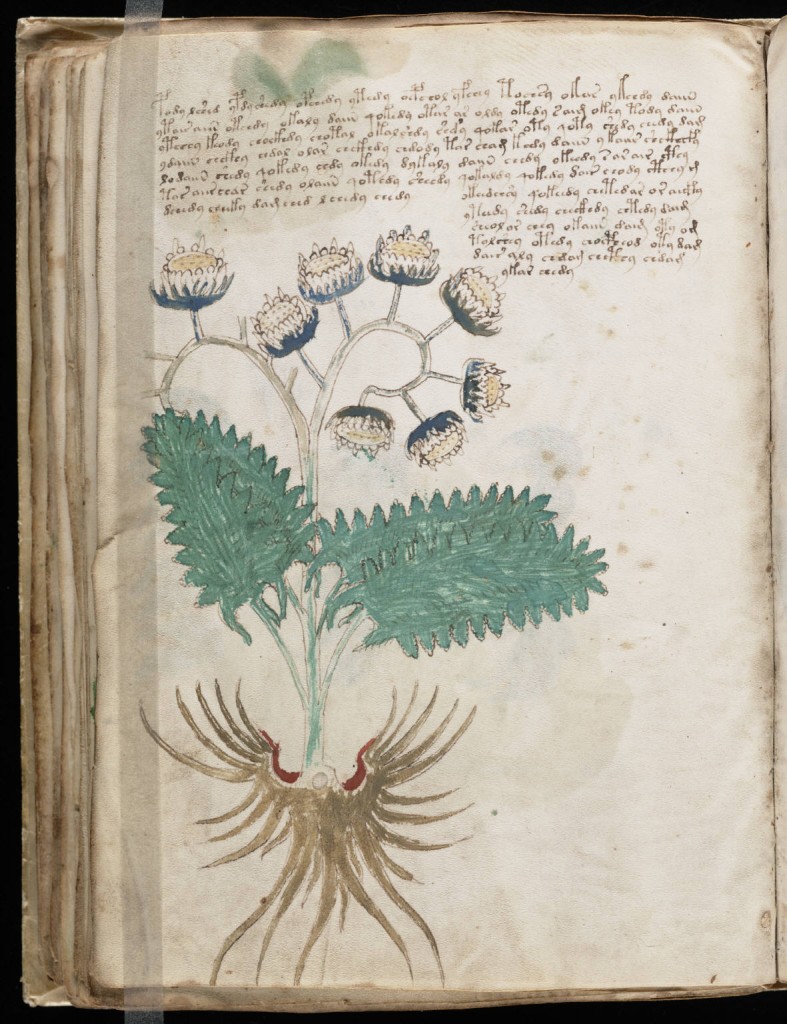
The Voynich Manuscript (Beinecke Rare Book & Manuscript Library, Yale)
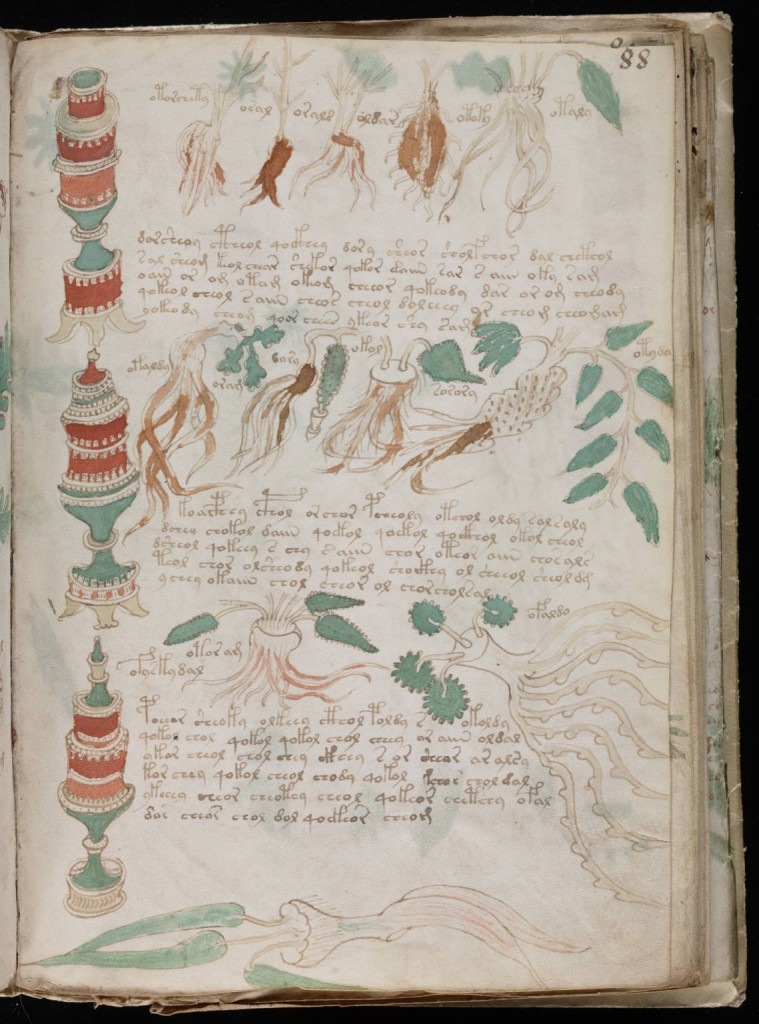
The Voynich Manuscript (Beinecke Rare Book & Manuscript Library, Yale)
For Newbold the botanical like imageries spread throughout the book were to be looked at from a defamiliarized point of view. Instead of scale one drawings of plants, which oddly might anticipate the Description’s plates, the images are rather microscopical views. As if the unknown author of the manuscript had looked at nature from a magnifying perspective.
This is certainly pure speculation based on loose associations. Remaining a quasi Enigma machinery, the VM has until now been impossible to translate. William Friedman who broke Japan’s Purple cipher, was himself defeated by this apparent simple suite of strokes, which he tought was «written in an artificial, constructed language [yet] such artificial languages were devised at least a century after the probable date of the Voynich manuscript»20.
It could still be an artificial language like the Lingua Ignota described by Hildegarde von Bingen in the XIIth century. It may also be a complete invention with no intelligible underlying text, similar to glossolalia21. Or simply, and perhaps surrealistically enough, the alphabet used in the VM is made of «psychologically random strings»22. An automatic writing so to speak, giving shape to a myriad of interpretations, freeing the reader from any sort of dogmatic translation.
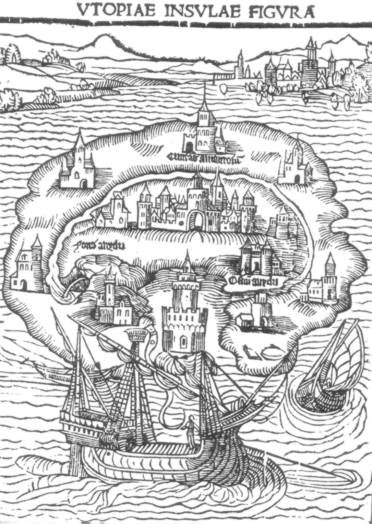
Illustration for the 1516 first edition of More’s Utopia
A probable amateur of paronomasia23, Thomas More coined the word utopia in 1516. From the Greek ou-topos meaning nowhere, it is a pun on the word eu-topos meaning a good place and underlines the hypothesis that an ideal world hardly exists or is to be invented. The eponymous book, written in latin by More, describes the island of Utopia and its political system seen from the perspective of a traveller called Raphael Hythlodaeus and whose name is another pun as its Greek meaning is literally «speaker of nonsense»24.
Utopia was first printed in Leuven but More made some revisions and in March 1518 the book had its third edition printed in Basel. This edition and the previous ones include the cryptic Utopian alphabet that More probably invented and which was based on «a series of symbols to replace (or encrypt) the letters of the Roman alphabet»25. Indeed the author of the Utopian alphabet could have also been printer and humanist Pieter Gillis.
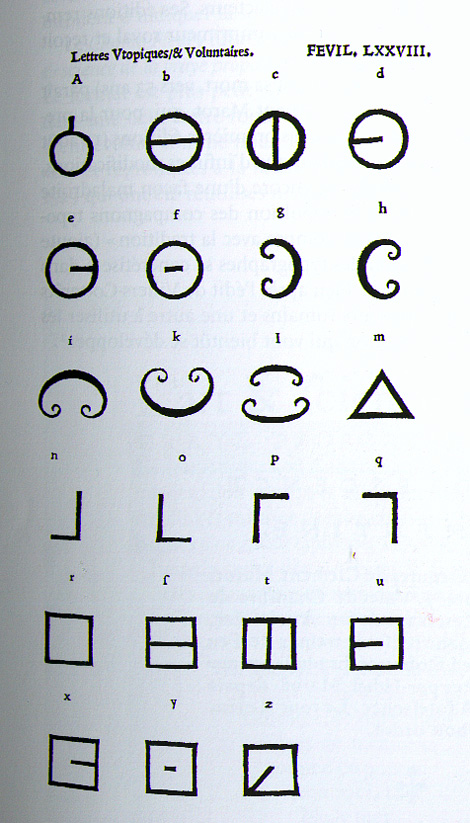
Thierry Martens (printer), Louvain, 1516
Thomas More, Utopia
Alphabets utopiques (utopiensium alphabetum)
[le troisième livre du Champ fleury de Geofroy Tory, 1529]
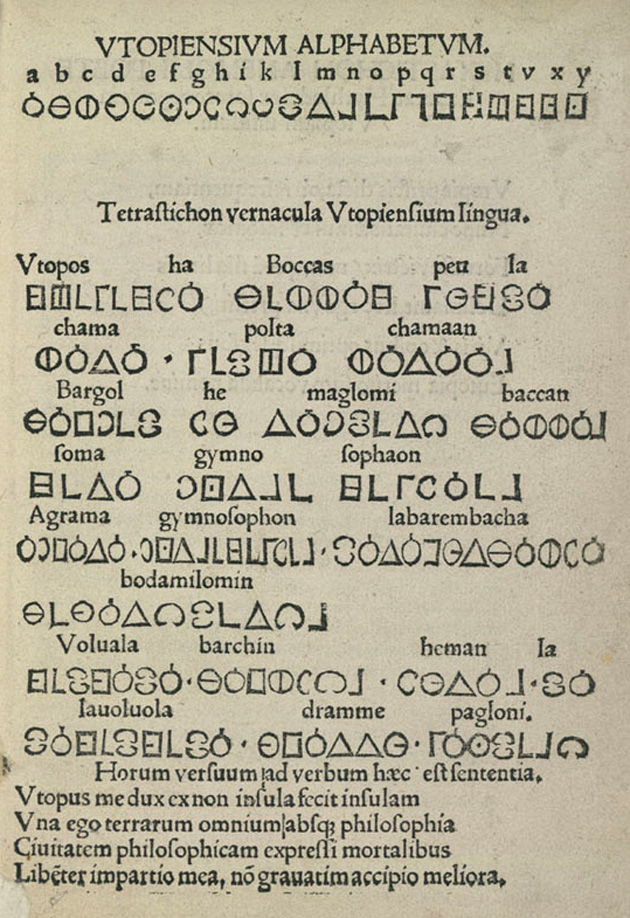
Thomas More’s utopian alphabet
Instructed by More to send a copy of the manuscript of The Island of Utopia to Jerome Busleyden26, Gillis wrote him a letter dated November 1st, 1516, where he mentionned that «there is, indeed, a little scrap of verse, written in the Utopian tongue, which Hythloday showed to me after More had gone away. I’ve prefixed to it an alphabet of the Utopian tongue, and added a few little notes in the margins.»27.
It seems Gillis wanted to perpetrate the veracity of the Utopian language and its alphabet and give it a little air of déjà -vu to maintain some credibility about the city-island of Utopia. As Richard Frimage notes in The Alphabet Abecedarium speaking of the Utopian alphabet: «these letterforms are a literary conceit or exercise in ingenuity meant to give a flavour of authenticity to fictional accounts of the civilization of imaginary societies»28.
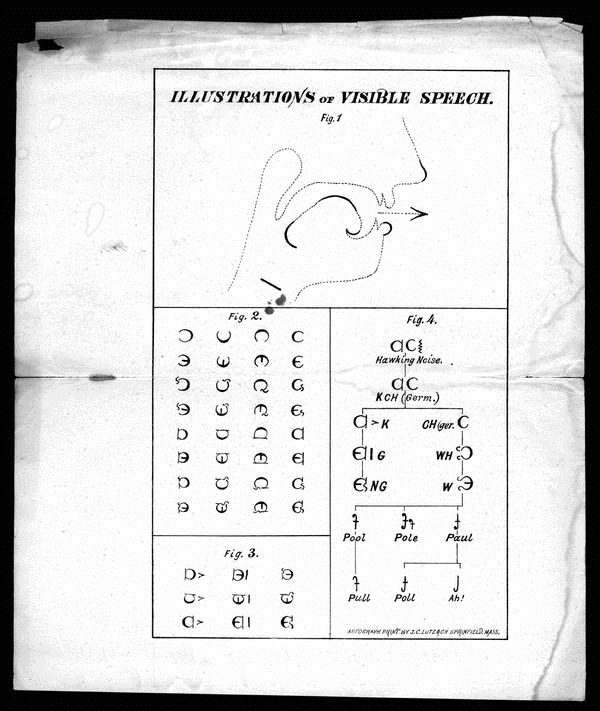
Chart Undated. Box 196, «Subject File: The Deaf–Visible Speech–Nature & Uses.» Alexander Graham Bell Family Papers, Mauscript Division, Library of Congress
The harder to decypher the more credible it became. As if illegibility was a token for another kind of truth. Sir Thomas More, the severe figure of Europe’s Renaissance and Humanism possibly invented a form of visual poetry, an exotic pun that can find formal echoes in the Visible Speech, a writing system invented by Alexander Melville Bell in 1867 where sound was translated into precise symbols and that bear some formal ressemblance with certain glyphs of the Utopian alphabet. The visual depiction of language was later used by Bell’s son Graham who improved his father’s invention with the use of a spectrograph, which «translated aural acoustic sounds into readable patterns via a photographic process»29.
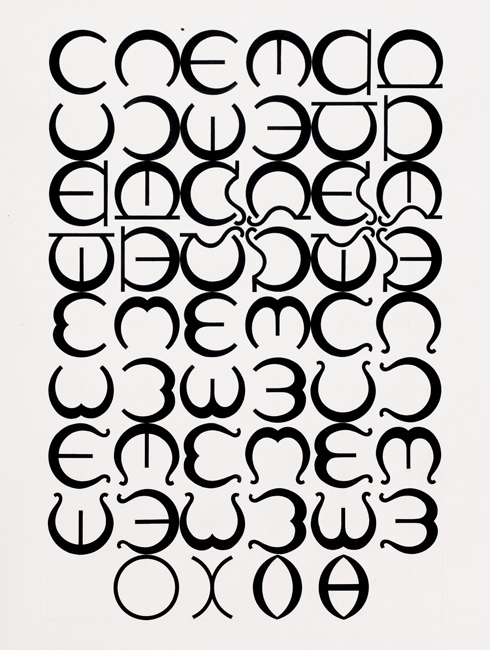
Tauba Auerbach, Alexander Melville Bell’s Visible Speech (consonants), 2006
This utopian desire to translate the sound of language was expanded in an oblique way with the photographic experiments of Raymond Hains and Jacques de la Villeglé. In the mid-XXth century, Hains invented a device called hypnagogoscope and which derives from his experiments with fluted glass. Using the hypnagogoscope’s distortive power with L’Hepérile, a  phonetic poem written by poet Camille Bryen in the 1950s, Hains and Villeglé generated L’Hepérile Éclaté. The cryptic deconstruction of language created by Bryen finding an alter ego in the deformed typography («ultra-lettres») generated by Hains’ machine.
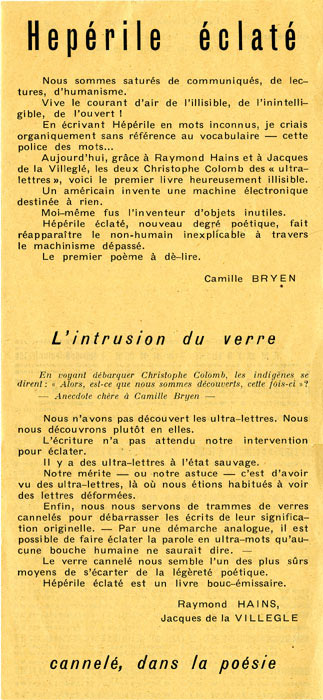
Camille Bryen, Raymond Hains, Jacques de la Villeglé, tract pour Hepérile éclaté, 1953 (fondation Hartung Bergman)
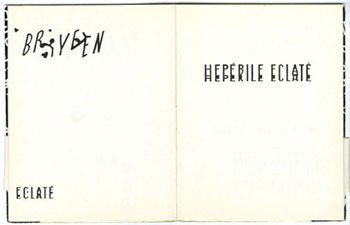
Camille Bryen, Raymond Hains, Jacques de la Villeglé, Hepérile éclaté, 1953 (fondation Hartung Bergman)
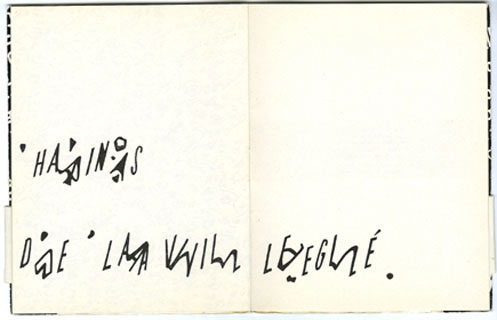
Camille Bryen, Raymond Hains, Jacques de la Villeglé, Hepérile éclaté, 1953 (fondation Hartung Bergman)
Bryen is so pleased with this ciphered and defamiliarized version of his poem he writes:
Long live the wind of unreadability, of illegibility, of the open! Today thanks to Raymond Hains and Jacques de la Villeglé, the two Colombus of ‘ultra-letters’, here comes the first joyfully unreadable book… the first poem to de-read [our translation]30.
Hains, another amateur of jeux de mots, literally reveals the estranged links words can have with things and signs31. The apparent hermetism of his hypnagogic photographs is a gesture of dépaysement (defamiliarization), a mode of deconstruction of language that allows for new meanings. This invitation to de-read a text, to generate another fictional alphabet is also to be found in the book Utopia in Utopia recently designed by Åbäke32.
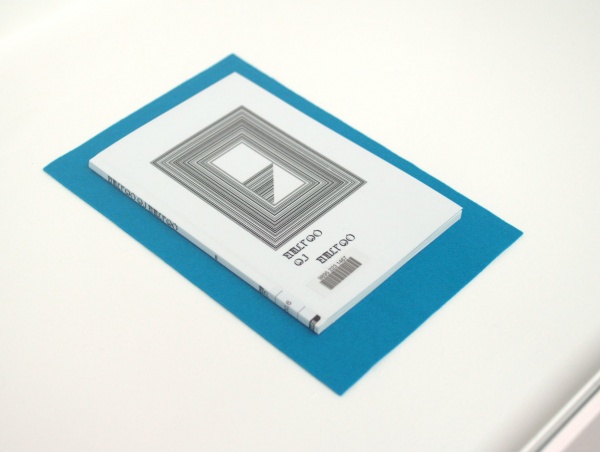
Åbäke, Utopia in utopia, 2011 («four copies of the book have been exhibited at De Kabinetten, sold at De Drvkkery and Antiquariaat De Boekenbeurs and available to borrow from Zeeuwse Bibliotheek»)
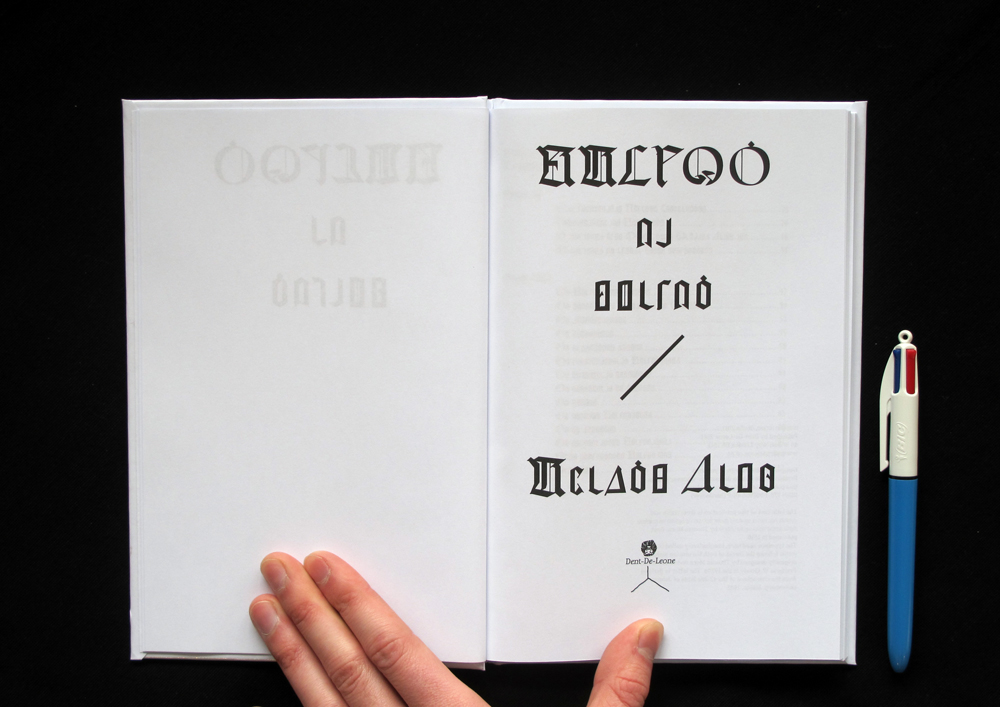
Åbäke, Utopia in utopia, 2011
Interestingly enough, Bryen’s expression «dé-lire» that I’ve translated de-read in English sounds like the verb dérider in French. It literally means to unwringle, to rejuvenate in a way. But dé-lire in French astutely sounds like délire, delirium. What Åbäke does with the publication Utopia in Utopia is a clever and deliciously delirious attempt at crypting all of More’s text. Their typeface is a sort of medieval transliteration as it were of the Utopian alphabet. More precisely, the book’s colophon explains: «the typeface used here, imaginatively called Goudy Utopia follows the forms of both the utopian alphabet originally designed by Thomas More and Goudy Text by Frederic W. Goudy in the 1920s. The latter is derived from the characters of the 42-line Bible of Johann Gutenberg, Mainz, 1455»33.
Keeping with the Freudian mot d’esprit, one can notice Utopia in Utopia is published by Dent-de-Leone, Åbäke’s «publishing hut». One may also remember that in the 1970s, Raymond Hains exhibited a giant matchbook, L’âne vêtu de la peau du lion, at the galleria del Leone. If a link should be made between the designers and the artist, it is evidently not to be found in the common word Leone34. Rather in a love of Witz and play on words or images leading to strangely hermetic but paradoxally very open productions.
The cover for Utopia in Utopia seems to encompass this hermetic openess or shall we say mucheness35. If the design of the inside of the book is unreadable but fantastically legible with a careful attention to typographic rules and contextualization36, the cover of the book is a drawing of a muchness37. It has that hermetic quality of being much more than what it seems, of allowing for a multitude of meanings none of which coming close to the original one. The latter seems to have been lost for the reader, just as the key to the Codex Seraphinianus.
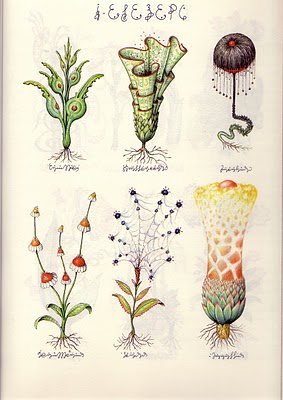
Luigi Serafini, The Codex Seraphinianus, 1981
This book, designed in the late 1970s by Luigi Serafini, was presented along More’s Utopia at the 2011 British Library’s exhibition: Out of this World: Science Fiction but nos as you know it. The Codex Seraphinianus is a sort of encyclopaedia of an imaginary, possibly alien, world. It is written in yet another unknown language made of a fictional alphabet. Serafini stated that there was no hidden meaning in his codex, more simply the writing system is similar to automatic writing conveying the nostalgic sensation a child has when confronted to books he cannot understand38.
As Alberto Manguel mentions in A History of Reading (1997), «the Codex Seraphinianus must be read without the help of common language, through signs for which there are no meanings except those furnished by a willing and inventive reader»39. Yet this high level of subjectivity we are subjected to when reading the Seraphinianus is tempered by a breach embedded within the pages of the codex.
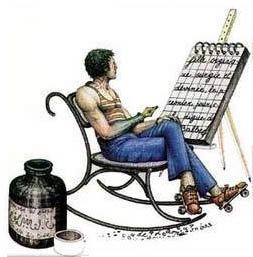
Luigi Serafini, Codex Seraphinianus, 1981
An illustration, which could echo Newbold’s nebula sentence in the Voynich manuscript, shows a man with rollers on, sitting in front of a giant notepad where a sentence is visible. Oddly it is the only text in the whole codex written in an intelligible language: the french description of Albertine written by Marcel Proust in Albertine disparue (1927): «fille orgiaque surgie et devinée, le premier jour sur la digue de Balbec»40.
An attempt at translating literally this sentence would be perilous. Let us just consider its context. Proust here describes the real Albertine, the one he first saw in Balbec and who has, in the vein of a traveller’s perception of a city from a distance who slowly gets closer to it, beared many aspects and forms. In order to reach what could be the original meaning of a sign, a reader and a viewer must face several other meanings. But is there such a thing as an original and unique meaning for each sign or each thing?
From Manguel to Proust the liaison is made easy to reach Borges the librarian prince of a certain magical hermetism. The tragic vision of the burned Institut d’Égypte paradoxally led to this lapidarian sketch around the word hermeti(c)ism and its oblique link to the surrealist notion of dépaysement. It also braught back to mind the final scene in Eco’s The Name of the Rose where William of Baskerville, despite the blind librarian Jorge de Burgos, a pun, tries to save the content of the hidden and burning library of a Benedectine monastery.
Umberto Eco’s story is a suite of clever references to medieval philosophy, hermetism and esoterism. Signs of various nature (from symbols to citations) are spread throughout the book. The reader is left with many keys and many doors, happily lost in the same labyrinth that forbids to access the hidden library but still leads to it.
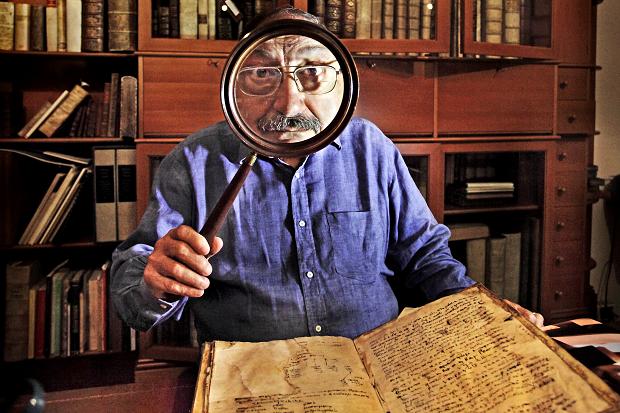
Umberto Eco photographed for The Times UK, 2011
Hermetism as the dépaysement of signs is similar to this labyrinth. It is an elegant and laughing crystal, one Breton described in his Éloge:
There could be no higher teaching than that of the crystal. The work of art, just like any fragment of human life considered in its deepest meaning, seems to me devoid of value if it does not offer the hardness, the rigidity, the regularity, the luster on every interior and exterior facet, of the crystal41
Close to the distortions of the hypnagogoscope, the diffractions caused by a crystal disassemble each sign; hermetism is no longer the complex but rather the expanded. It brings forth an explosion of meanings, a constellation of fragmented and unhierarchised signs exulting in a constant deconstruction opening up to singular and oblique understandings and editings.
- William Romaine Newbold’s 1919 translation of one of the pages of the cryptic Voynich Manuscript. I am indebted to my friend Francisco Laranjo who was at the starting point of this modest research around the possible dialogue between graphic design and hermetism. [↩]
- L’incendie de l’Institut d’Égypte, «une catastrophe pour la science», Le Monde / AFP, 18 december 2011 [↩]
- See: Thoth Attributes [accessed December 20, 2011] [↩]
- «Hermès Trismégiste est issu de la fusion de Thot et d’Hermès»: Garth Fowden, Hermès l’Égyptien (1986), trad., Les Belles Lettres, coll. «l’âne d’or», 2000 [↩]
- Frances Yates, Giordano Bruno et la tradition hermétique (1964), Dervy, 1988 [↩]
- Dominique Bertrand, L’entre-dieux. See: Trouveur d’Or [accessed December 20, 2011] [↩]
- Bernard Joly, « La rationalité de l’hermétisme », Methodos [en ligne], 3|2003, mis en ligne le 05 avril 2004, consulté le 20 décembre 2011. url: http://methodos.revue.org/106 ; DOI : 10.4000/methodos.106 [↩]
- Frances Yates, Op. Cit. [↩]
- Dominique Bertrand, Op. Cit. [↩]
- Jean Weisberger, Les avant-gardes littéraires au XXe siècle, Budapest, Academiai Kiado, 1984 [↩]
- «The surrealist map of the world, Le Monde au temps des surréalistes, imagined by an anonymous cartographer in 1929 […] exposes the ideology of imperialist maps and troubles established views of centre and margins. It can be read as a model of surrealist dépaysement or disorientation»: Elza Adamowicz (ed.), Surrealism Crossings/Frontiers, Peter Lang (European Connections 18), 2006 [↩]
- «Le fait que Freud et le jeune Jung avaient interrogé des textes de Goethe ou de Shakespeare suscita le projet de produire le ‘minerai brut’, ‘l’or’ de la pensée» [my emphasis]. See: Comptoir Littéraire [accessed December 20, 2011] [↩]
- In 1937 Antonin Artaud, on a mission in the Sierra tarahumara in Mexico has the secret desire to take part in an Indian ritual ceremony. Finally meeting with the Indians Peyotl, Artaud lives a ‘magical moment’ and translates it into haunted drawings. Two texts published in El Nacional Revolutionario (31 October 1937) also describe this experience. One of them La Montagne des signes (‘The Mountain of Signs’), tells the climbing of a mountain where every single stone adorns a particular form and reveals to Artaud the magic of signs that have the power to evoke something that was once, something that is not there. This regime of revelation of the absent is already present in Artaud’s definition of the (cinematic) image in Sorcery and Cinema (1928): «Any image, even the slightest and most banal, is transfigured on the screen. The smallest detail and the most insignificant object take on the meaning and the life that pertains to each of them. One that tends to become ever more independent and to detach itself from the habitual meaning these objects have.» [↩]
- Andrzej Gasiorek, JG Ballard, Manchester University Press, 2005 [↩]
- Ibid. [↩]
- Mary D’Imperio, The Voynich Manuscript – an elegant enigma, Aegean Park Press, 1981 [↩]
- See: World Mysteries [accessed December 21, 2011]. «The Voynich manuscript’s ‘language’ is different from other languages (both modern and ancient) in several ways: There are practically no words comprising more than ten characters, yet there are also few one- or two-letter words. The distribution of letters within words is also rather peculiar: some characters only occur at the beginning of a word, some only at the end, and some always in the middle section. The text seems to be more repetitive than most known languages; there are instances where the same common word appears up to three times in a row. Words that differ only by one letter also repeat with unusual frequency. The text consists of over 170,000 discrete characters, usually (but not always)separated from each other by narrow gaps. Wider gaps divide the text into about 35,000 ‘words’ of varying length.» [↩]
- See: Deciphering the most mysterious manuscript in the world [accessed December 21, 2011] [↩]
- See: Voynich Manuscript [accessed December 21, 2011]. See also: http://www.omniglot.com/writing/shorthand.htm [accessed December 21, 2011] [↩]
- See: World Mysteries [accessed December 21, 2011] [↩]
- «Glossolalia consists of strings of meaningless syllables made up of sounds taken from those familiar to the speaker and put together more or less haphazardly». See: The Skeptic’s Dictionary [accessed December 21, 2011] [↩]
- See: World Mysteries [accessed December 22, 2011] [↩]
- The word paronomasia comes from the Greek para (alongside) and onomos (name): «to alter slightly in naming, to use words that sound alike but that differ in meaning (punning)» See: Paronomasia [accessed December 19, 2011] [↩]
- Elizabeth McCutcheon, «Thomas More, Raphael Hythlodaeus, and the Angel Raphael, in Studies in English Literature, 1500-1900, Vol.9, Nº1, Winter 1969 [↩]
- See: British Library, The Utopian Alphabet [accessed December 19, 2011] [↩]
- Jerome Busleyden was «an elderly man, well known in the world, wealthy and substantial […] During his embassy on the Continent, More had met Busleyden and had much admired his splendid house at Mechlin, as well as his impressive collection of antique coins.» See: Uppsala Universitet [accessed December 19, 2011] [↩]
- See: Giles to Busleiden [accessed December 19, 2011] [↩]
- Richard Firmage, The Alphabet Abecedarium, Bloomsbury Publishing, 2000. I am grateful to Suzanne McCarthy for pointing to this book in her enlightening post. See: Utopian Alphabet [accessed December 19, 2011] [↩]
- See: Visible Speech [accessed December 20, 2011] [↩]
- See: Mudam Hains [accessed December 19, 2011] [↩]
- Marie Colombet, L’humour objectif: Roussel, Duchamp, «sous le capot»: l’objectivation du surréalisme, EPU, 2008 [↩]
- Simon Elvins has this sharp description: «Åbäke is a design studio based in London, although they also co-edited and designed the magazine Sexymachinery, co-direct a clothing and record label Kitsuné, run a publishing house Dent-De-Leone and I’m sure a lot else on top and in between this. This in-betweenness seems central to their work» See: Ã…bäke [accessed December 19, 2011] [↩]
- See: Dent de Leone [accessed December 20, 2011] [↩]
- Definitely a coïncidence, it is albeit intriguing enough to notice the lion’s figure in both Ã…bäke and Hains’ work. An exploring and extrapolative mind might remember that the noun Lion was used in the mid-XIXth century to describe an ultra dandy. As Vicomte de Launay notes in his Lettres Parisiennes (1857): «a lion is a curious moral beast […] do not mistake the dandy and the lion, they do not belong to same family: the dandy wants to be seen, everyone wants to see the lion […] The Lion (pronounced âne) […] is not the tiger, nor the leopard or the lamb or even the lion itself: it is Mr Van Amburgh» [our translation]. Van Amburgh was a renowned and daring animal trainer. Despite his brutal behavior with animals he was famous for his acts of bravoure in the cages. If Hains and Ã…bäke are not to be compared to Van Amburgh, their work still represents a certain spirit of domptage: it is a genuine and brave game of taming where signs and images find themselves almost dandyfied. As Julien Zanetta notes: «Françoise Coblence in her essential book on dandysm (Le Dandysme, obligation d’incertitude, PUF, 1988) had precisely described its function: ‘the perfection of the character operates the seizing of the instant; it is an ever beginning creation. The dandy embodies and produces the ephemeral’ » This almost intangible meaning, this incertitude is a symptom visible in Hains and Ã…bäke work: nothing seems to be a closed system, rather an open series of astute combinations. See: Le Lion Véritable [accessed 19 December, 2011]. See also: Fabula [accessed 19 December, 2011] [↩]
- The word first appeared in The Provok’s Husband (1728) a play written by Cibber and Vanbrugh. In Alice in Wonderland (1865) Lewis Carroll, during the Mad Tea-Party, has the Dormouse says « That begins with an M, such as… muchness – you know you say things are ‘much of a muchness’ – did you ever see… a drawing of a muchness?». See: Mucheness [accessed 19 December, 2011] [↩]
- Sir Thomas More was a fervent catholic, hybriding his utopian alphabet with Goudy’s adaptation of the characters of Gutenberg’s Bible is an appreciable clin d’œil. [↩]
- See: http://www.worldwidewords.org/qa/qa-muc1.htm [accessed 20 December, 2011] [↩]
- See: Codex Seraphinianus [accessed 20 December, 2011] [↩]
- See: Codex [accessed 20 December, 2011] [↩]
- See: La Fille Orgiaque [accessed December 19, 2011] [↩]
- André Breton, Mad Love, trans. S. MacKenna, Penguin, 1991 [↩]
